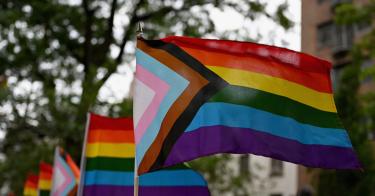For the second year in a row, the U.S. embassy to the Vatican has flown the “Pride” flag. To what purpose?
We know the position of the Catholic church on matters of homosexuality, and surely they know the state of current American law and society. (If not, we have a fully staffed embassy there to explain it to the Vatican’s entire population of around 800.) Who in that tiny city is supposed to be inspired by that flag, and to what end?
The flagpole outside a U.S. embassy or facility overseas should fly only one flag: the Stars and Stripes, supported by a base or unit pennant where appropriate. Flying a flag symbolizing domestic political positions is undiplomatic virtue-signaling at best, and counter-productive provocation at worst.
Last year, in anticipation of Pride month, Secretary of State Antony Blinken authorized U.S. ambassadors to fly the Pride flag, but left it to their discretion, based on local conditions. Discretion is the coin of diplomacy. We do not fly a feminist flag (there is one) outside of our embassies in the Middle East, nor the Taiwanese or Tibetan flags outside Embassy in Beijing, because doing so would inform no one, accomplish nothing, and needlessly irritate already difficult relationships. Flags are to diplomacy what skywriting is to marriage proposals: unsubtle and hard to walk back.
>>> Why America Needs Better Men
Last year, several U.S. embassies and consulates flew Black Lives Matter flags to recognize George Floyd or the Juneteenth holiday. A State Department memo at the time said: “The Department … encourage[s] posts to focus on the need to eliminate systemic racism and its continued impact.” According to the left, America is infused with “systemic racism,” an invisible web of laws, practices, and values that feed white supremacy and repress people of color. Even if one were to accept this contentious theory, is it applicable to our foreign relations with Benin, or Bangladesh, whose social tensions have completely different roots in tribe or caste? We undermine American credibility when we seek to export, symbolically, all but the most essential and unchanging of our values.
While it is obvious U.S. policy that black lives matter, flying a flag closely associated with the BLM organization founded by Patrisse Cullors and Alicia Garza implies official U.S. support for a domestic group that has done little tangible good, allegedly misspent millions of donor dollars, and espoused specific policies—such as “defund the police” and “ban former President Trump from future political office”—that are not supported by the current administration, let alone most Americans. The organization also bears hostility to the state of Israel. BLM’s aggressive pro-Palestinian stance is just one, extreme position held by one segment of the progressive movement, and it certainly does not reflect official U.S. foreign policy.
So, about that Pride flag… President Biden’s very first Executive Order “directed all federal agencies to implement fully all federal laws that prevent discrimination on the basis of sex, to include … gender identity.” It also speaks of “gender-affirming medical care.” These concepts are far from firmly agreed or entrenched in U.S. law or culture.
Early medical intervention for teenagers has cemented into administration policy, although it puts children on a path to sterilization and life-long medical complications. However, there has been serious expert re-thinking of the idea that children presenting with body dysphoria, or who identify with a gender that does not match their biological sex, should be “affirmed” through prescription of puberty blocking drugs, cross-sex hormones, and surgery.
In light of evidence that most children with body dysphoria grow out of it after puberty, and seeing the permanent harm caused by misguided early transitions, several governments in Europe have reversed earlier policies requiring “affirmative” treatment of children and adolescents.
Today’s Pride parade is not the celebration of tolerance it once was. The mayor of San Francisco, of all places, refused to march in this year’s parade after organizers banned all police officers—including “LGBTQ+ officers [who] march voluntarily and without compensation”—from marching in uniform because “the presence of the police in the parade is difficult for them, given their history with the police department.” Firefighters boycotted in solidarity, and thus what could have been a celebration of progress and tolerance turned into a circular firing squad with ever-decreasing circles of virtue.
>>> State of the Union: An Annual Review of Sexual Orientation and Gender Identity Legislation
Today’s Pride flag is not the simple rainbow of the 1970s, signifying pride and acceptance of same-sex attraction. The updated version is a profusion of stripes, chevrons, and circles, with at least 12 colors indicating different points of view, including people who “identify outside the gender binary.” Is this ever-changing tableau of social discussion something we should run up the flagpole at our missions overseas next to Old Glory, whose meaning has been clear for generations and is (in theory) shared by all Americans?
American society is still wrestling with issues of race, gender, and politics; we are in no position to preach to others. What happened to the idea, as Sen. Arthur Vandenburg put it in 1947, that “we must stop partisan politics at the water’s edge”? Do ambassadors in favor of gun rights get to fly the NRA flag? How about the D.C. flag supporting statehood for the District of Columbia? What about flags symbolizing positions on abortion, or immigration?
Granting ambassadors the leeway to fly flags according to their individual ideological bent or local sentiments does not present a united policy front abroad. Rather, it will send confused and uncoordinated messages to our allies as well as our enemies. The Biden administration and Secretary of State Blinken should direct that, henceforth, only the Stars and Stripes fly over our foreign missions.
This piece originally appeared in 19fortyfive




